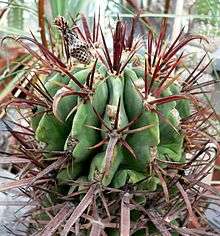Ferocactus latispinus
Ferocactus latispinus is a species of barrel cactus native to Mexico. Originally described as Cactus latispinus in 1824 by English naturalist Adrian Hardy Haworth, it gained its current name in 1922 with the erection of the genus Ferocactus by American botanists Britton and Rose.[1] The species name is derived from the Latin latus "broad", and spinus "spine". Ferocactus recurvus is a former name for the species.[1]
| Ferocactus latispinus | |
|---|---|
 | |
| cult. University of California Botanical Garden | |
| Scientific classification | |
| Kingdom: | |
| (unranked): | |
| (unranked): | |
| (unranked): | Core eudicots |
| Order: | |
| Family: | |
| Genus: | |
| Species: | F. latispinus |
| Binomial name | |
| Ferocactus latispinus | |
| Synonyms | |
| |
Distribution
.jpg)
The species is endemic to Mexico; the more widely distributed subspecies latispinus ranges from southeastern Durango, through Zacatecas, Aguascalientes, east to the western parts of San Luis Potosí, Hidalgo and Puebla, as well as to eastern Jalisco, Guanajuato, Querétaro and Mexico State. Subspecies spiralis is restricted to the southern parts of Oaxaca and Puebla.[1]
Description
Ferocactus latispinus grows as a single globular light green cactus reaching the dimensions of 30 cm (12 in) in height and 40 cm (16 in) across, with 21 acute ribs. Its spines range from reddish to white in colour and are flattened and reach 4 or 5 cm long. Flowering is in late autumn or early winter.[2] The funnel-shaped flowers are purplish or yellowish and reach 4 cm long, and are followed by oval-shaped scaled fruit which reach 2.5 cm (1 in) long.[1]
Cultivation
Ferocactus latispinus is fairly commonly cultivated as an ornamental plant. It blooms at an early age which is a desirable horticultural feature. It is hardy to −4 °C, with an average minimum temperature of 10 °C.[2]
The slime mold, Didymium wildpretii feeds on the decaying remains of F. latispinus in Mexico.[3]
References
- Anderson, Edward F. (2001). The cactus family. Timber Press. p. 332. ISBN 0-88192-498-9. Retrieved 28 August 2010.
- "Devil's Tongue Barrel, Crow's Claw Cactus". Desert Tropicals website. Retrieved 28 August 2010.
- Lado, C.; Mosquera, J.; Estrada-Torres, A.; Beltran-Tejera, E.; De Basanta, D. W. (2007). "Description and culture of a new succulenticolous Didymium (Myxomycetes)". Mycologia. 99 (4): 602–611. doi:10.3852/mycologia.99.4.602. PMID 18065011.